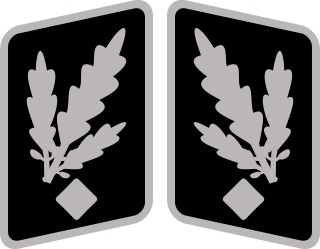
Gruppenführer was an early paramilitary rank of the Nazi Party (NSDAP), first created in 1925 as a senior rank of the SA. Since then, the term Gruppenführer is also used for leaders of groups/teams of the police, fire departments, military and several other organizations.

The uniforms and insignia of the Schutzstaffel (SS) served to distinguish its Nazi paramilitary ranks between 1925 and 1945 from the ranks of the Wehrmacht, the German state, and the Nazi Party.
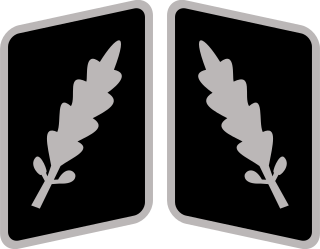
Standartenführer was a Nazi Party (NSDAP) paramilitary rank that was used in several NSDAP organizations, such as the SA, SS, NSKK and the NSFK. First founded as a title in 1925, in 1928 it became one of the first commissioned NSDAP ranks and was bestowed upon those SA and SS officers who commanded a unit known as a Standarte, a unit equivalent to an army battalion and comprising 300–500 personnel.

Hauptsturmführer was a Nazi Party paramilitary rank that was used in several Nazi organizations such as the SS, NSKK and the NSFK. The rank of Hauptsturmführer was a mid-level commander and had equivalent seniority to a captain (Hauptmann) in the German Army and also the equivalency of captain in foreign armies.
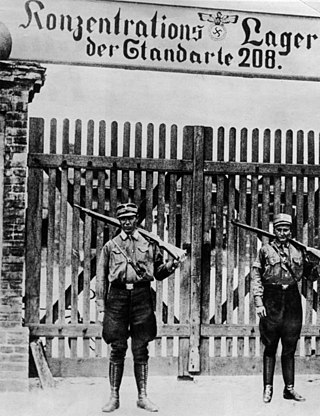
The uniforms and insignia of the Sturmabteilung (SA) were Nazi Party paramilitary ranks and uniforms used by SA stormtroopers from 1921 until the fall of Nazi Germany in 1945. The titles and phrases used by the SA were the basis for paramilitary titles used by several other Nazi paramilitary groups, among them the Schutzstaffel (SS). Early SS ranks were identical to the SA, since the SS was originally considered a sub-organization of the Sturmabteilung.

Scharführer was a title or rank used in early 20th Century German military terminology. In German, Schar was one term for the smallest sub-unit, equivalent to a "troop", "squad", or "section". The word führer simply meant "leader".

Sturmmann was a Nazi Party paramilitary rank that was first created in the year 1921. The rank of Sturmmann was used by the Sturmabteilung (SA) and the Schutzstaffel (SS).
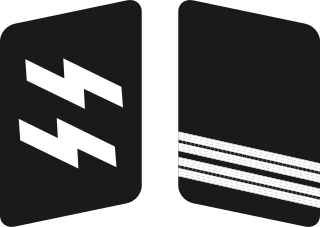
Rottenführer was a Nazi Party paramilitary rank that was first created in the year 1932. The rank of Rottenführer was used by several Nazi paramilitary groups, among them the Sturmabteilung (SA), the Schutzstaffel (SS) and was senior to the paramilitary rank of Sturmmann.

Oberscharführer was a Nazi Party paramilitary rank that existed between 1932 and 1945. Oberscharführer was first used as a rank of the Sturmabteilung (SA) and was created due to an expansion of the enlisted positions required by growing SA membership in the late 1920s and early 1930s. The SA rank of Oberscharführer was senior to Scharführer and junior to the rank of Truppführer.

Ranks and insignia were used by the National Socialist German Workers' Party (NSDAP) as paramilitary titles between approximately 1928 and the fall of Nazi Germany in 1945. Such ranks were held within the political leadership corps of the Nazi Party, charged with the overseeing of the regular Nazi Party members.
National Socialist paramilitary ranks were pseudo-military titles, which were used by the Nazi Party, between 1920 and 1945. Since the Nazi Party was by its very nature a paramilitary organisation, by the time of World War II, several systems of paramilitary ranks had come into existence for both the Nazi Party itself and various Nazi paramilitary organisations.

The National Socialist Flyers Corps was a paramilitary aviation organization of the Nazi Party.

The National Socialist Motor Corps was a paramilitary organization of the Nazi Party (NSDAP) that officially existed from May 1931 to 1945. The group was a successor organisation to the older National Socialist Automobile Corps, which had existed since April 1930.

Adolf Hühnlein was a German soldier and Nazi Party (NSDAP) official. He was the Korpsführer of the National Socialist Motor Corps (NSKK) from 1933 until his death in 1942.
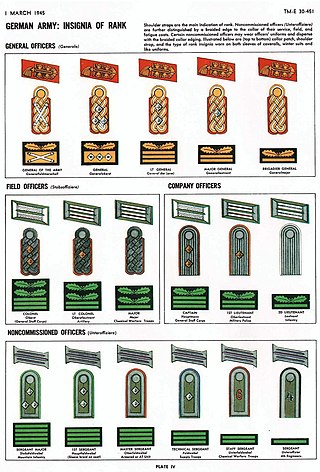
The Heer as the German army and part of the Wehrmacht inherited its uniforms and rank structure from the Reichsheer of the Weimar Republic (1921–1935). There were few alterations and adjustments made as the army grew from a limited peacetime defense force of 100,000 men to a war-fighting force of several million men.
Hermann Höfle was a German SS and police official during the Nazi era who served as SS and Police Leader (HSSPF).
Corps colours, or troop-function colours were traditional worn in the German Wehrmacht from 1935 until 1945 as discrimination criteria between several branches, special services, corps, rank groups and appointments of the ministerial area, general staff, Oberkommando der Wehrmacht, up to the military branches Heer, Luftwaffe and Kriegsmarine. With the formation of the Waffen-SS and so-called Gesamt-SA by simultaneous new-structuring in line with military principles, corps coloures were introduced to these organizations as well.
Legion Speer was a Nazi German paramilitary motor transportation corps founded in 1942. The members of the Legion were non-German citizens, and as such could not belong to the Nationalsozialistisches Kraftfahrkorps (NSKK). The legion was disbanded in 1944, and its members absorbed into the Transportkorps Speer. It was named after Albert Speer.
Transportkorps Speer was created in 1944 from Legion Speer and the units of the National Socialist Motor Corps that was serving the Organisation Todt. Shortly after its creation it became subordinated to the Wehrmacht. Yet, its major mission remained in support of OT, which at this time was mainly engaged in rebuilding and repair of bomb damaged industrial facilities and housing complexes. Transportkorps Speer was organized in motor transportation battalions and regiments, supported by depot, repair, engineering, signal, and medical units.

































